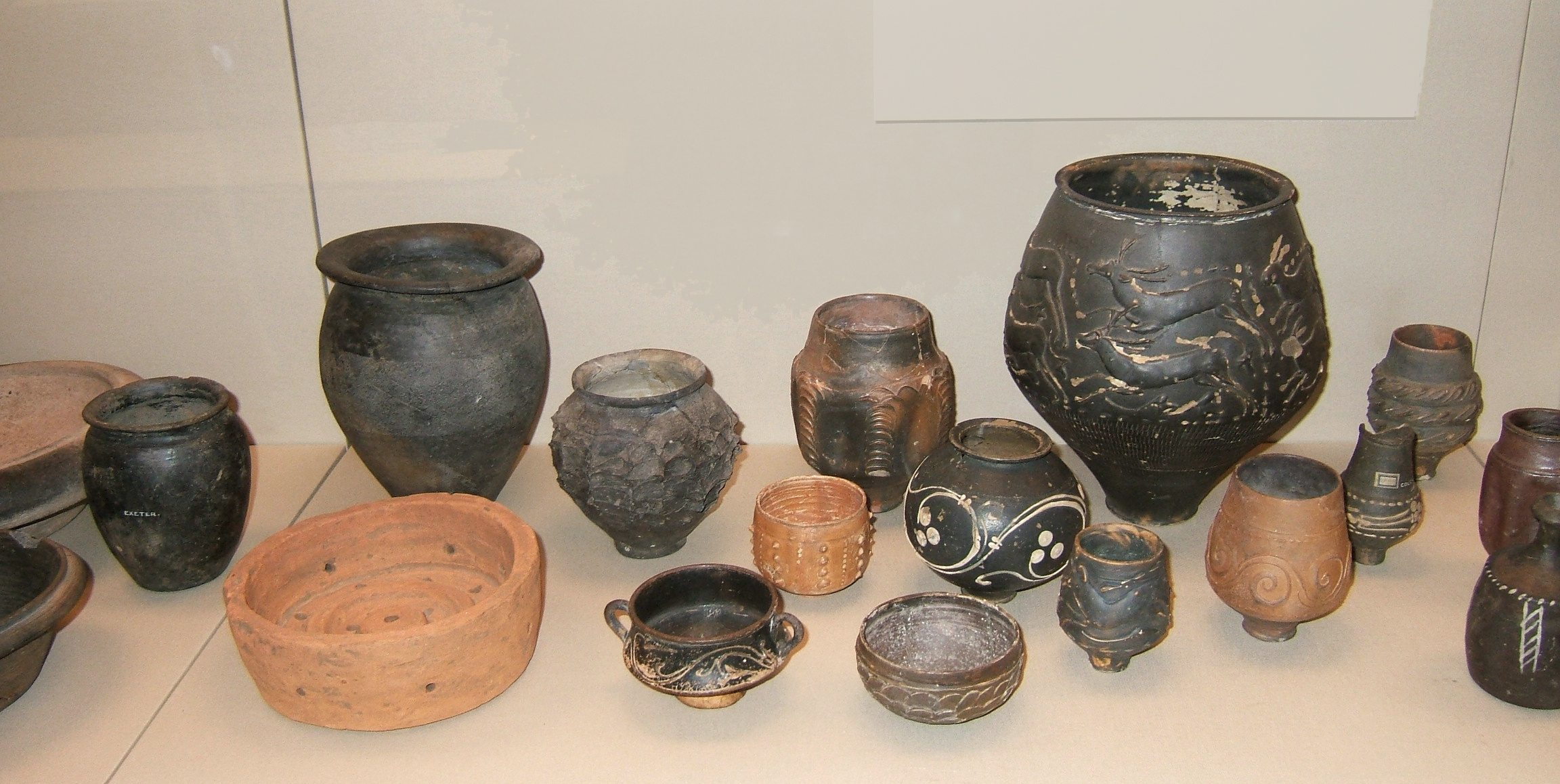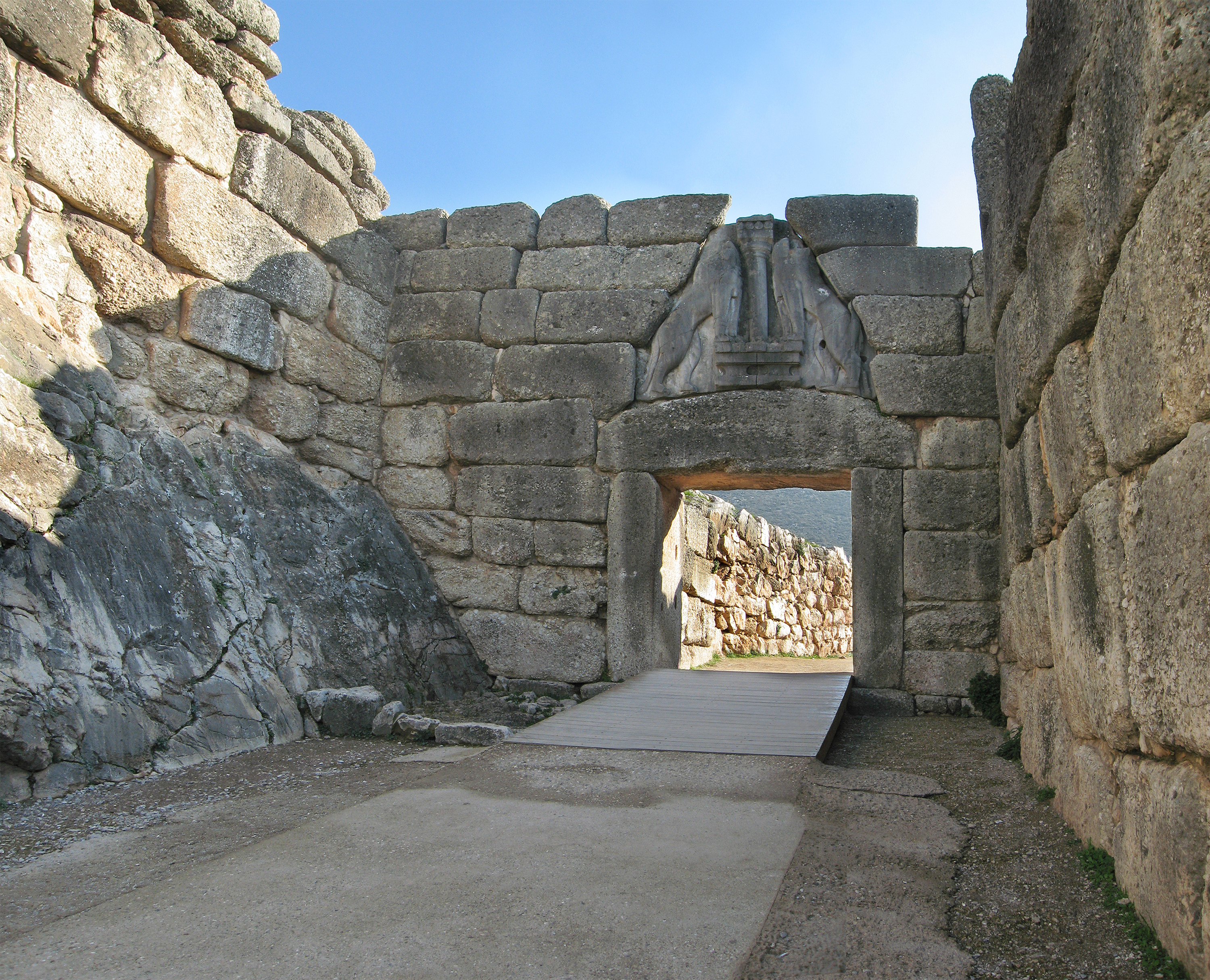|
Slip-trailing
Slipware is pottery identified by its primary decorating process where slip is placed onto the leather-hard (semi-hardened) clay body surface before firing by dipping, painting or splashing. Slip is an aqueous suspension of a clay body, which is a mixture of clays and other minerals such as quartz, feldspar and mica. The slip placed onto a wet or leather-hard clay body surface by a variety of techniques including dipping, painting, piping or splashing. Principal techniques include slip painting, where the slip is treated like paint and used to create a design with brushes or other implements, and slip trailing, where the slip, usually rather thick, is dripped, piped or trailed onto the body, typically from some device like the piping bag used to decorate cakes. The French term for slip is barbotine, and this term may be used for both techniques, but usually from different periods. Often only pottery where the slip creates patterns or images will be described as slipware, ... [...More Info...] [...Related Items...] OR: [Wikipedia] [Google] [Baidu] |
Slip (ceramics)
A slip is a clay slurry used to produce pottery and other ceramic wares. Liquified clay, in which there is no fixed ratio of water and clay, is called slip or clay slurry which is used either for joining leather-hard (semi-hardened) clay body (pieces of pottery) together by slipcasting with mould, glazing or decorating the pottery by painting or dipping the pottery with slip.What is slip in pottery thepotterywheel.com, accessed 10 July 2021. Pottery on which slip has been applied either for glazing or decoration is called slipware. Engobe, from the French word for slip, is a related term for a liquid suspension of clays and flux, in addition to ... [...More Info...] [...Related Items...] OR: [Wikipedia] [Google] [Baidu] |
Thomas Toft
Thomas Toft (died November 1698) was an English potter working in the Staffordshire Potteries during the 17th century. He and his family are known for large earthenware plates heavily decorated by slip-trailing, often in several colours. Work in this style, even by other makers, is known as Toft ware. Pottery It is thought that Toft, who may have been of Scandinavian origin, operated in the Burslem district during at least 1671–1689. The Staffordshire potters were at that time known for the excellence of their slipware; a kind of coarse earthenware decorated with a coloured clay and water mixture of cream-like consistency called slip (ceramics), slip. Sometimes a red slip was trailed on to a lighter background, sometimes vice versa. Black and green slips were also used. According to the common practice of the time, these earthenwares were glazed with a galena lead oxide glaze, giving them their characteristic yellow tinge. Designs attributed to Thomas Toft include mermaids ... [...More Info...] [...Related Items...] OR: [Wikipedia] [Google] [Baidu] |
Glossary Of Pottery Terms
This is a list of pottery and ceramic terms. :''Definitions in Wiktionary are noted as "(W)".'' A B ( W) ( W) C D E F G H I J K L M O P :Published definitions of Pottery include: :-- "All fired ceramic wares that contain clay when formed, except technical, structural, and refractory products." :-- "China, earthenware and any article made from clay or from a mixture containing clay and other materials." :-- "A class of ceramic artifacts in which clay is formed into containers by hand or in molds or with a potter's wheel, often deco ... [...More Info...] [...Related Items...] OR: [Wikipedia] [Google] [Baidu] |
Ancient Roman Pottery
Pottery was produced in enormous quantities in ancient Rome, mostly for utilitarian purposes. It is found all over the former Roman Empire and beyond. Monte Testaccio is a huge mound, waste mound in Rome made almost entirely of broken amphorae used for transporting and storing liquids and other products – in this case probably mostly Spanish olive oil, which was landed nearby, and was the main fuel for lighting, as well as its use in the kitchen and washing in the Thermae, baths. It is usual to divide Roman domestic pottery broadly into coarse wares and fine wares, the former being the everyday pottery jars, dishes and bowls that were used for cooking or the storage and transport of foods and other goods, and in some cases also as tableware, and which were often made and bought locally. Fine wares were serving vessels or tableware used for more formal dining, and are usually of more decorative and elegant appearance. Some of the most important of these were made at specialised ... [...More Info...] [...Related Items...] OR: [Wikipedia] [Google] [Baidu] |
Barbotine
wikt: barbotine, Barbotine is the French for slip (ceramics), ceramic slip, or a mixture of clay and water used for moulding or decorating pottery. In English the term is used for three different techniques of decorating pottery, though in all cases mainly for historical works. For clarity, these types are numbered here as A-C (which are not standard terms). A: Piped slip decoration In the first, common from the Ancient World onwards, the barbotine is piped onto the object rather as cakes are decorated with icing, using a quill, horn, or other kind of nozzle. The slip would normally be in a contrasting colour to the rest of the vessel, and forms a pattern, or inscription, that is slightly raised above the main surface. This is normally called slip-trailing in English today, and for English pottery (such as the works of Thomas Toft, d. 1698), but "barbotine" remains common in archaeology. The first barbotine technique in pottery styling was in use in the ancient world. The ... [...More Info...] [...Related Items...] OR: [Wikipedia] [Google] [Baidu] |
Mycenaean Period
Mycenaean Greece (or the Mycenaean civilization) was the last phase of the Bronze Age in ancient Greece, spanning the period from approximately 1750 to 1050 BC.. It represents the first advanced and distinctively Greek civilization in mainland Greece with its palatial states, urban organization, works of art, and writing system.. The Mycenaeans were mainland Greek peoples who were likely stimulated by their contact with insular Minoan Crete and other Mediterranean cultures to develop a more sophisticated sociopolitical culture of their own. The most prominent site was Mycenae, after which the culture of this era is named. Other centers of power that emerged included Pylos, Tiryns, and Midea in the Peloponnese, Orchomenos, Thebes, and Athens in Central Greece, and Iolcos in Thessaly. Mycenaean settlements also appeared in Epirus, Macedonia, on islands in the Aegean Sea, on the south-west coast of Asia Minor, and on Cyprus, while Mycenaean-influenced settlements appeare ... [...More Info...] [...Related Items...] OR: [Wikipedia] [Google] [Baidu] |
Culture Of Japan
Japanese culture has changed greatly over the millennia, from the country's prehistoric Jōmon period, to its contemporary modern culture, which absorbs influences from Asia and other regions of the world. Since the Jomon period, ancestral groups like the Yayoi and Kofun, who arrived to Japan from Korea and China, respectively, have shaped Japanese culture. Rice cultivation and centralized leadership were introduced by these groups, shaping Japanese culture. Chinese dynasties, particularly the Tang dynasty, have influenced Japanese culture throughout history and brought it into the Sinosphere. After 220 years of isolation, the Meiji era opened Japan to Western influences, enriching and diversifying Japanese culture. Popular culture shows how much contemporary Japanese culture influences the world. Identity There are two competing hypotheses that try to explain the lineage of the Japanese people. The first hypothesis proposes a dual-structure model, in which Japanese po ... [...More Info...] [...Related Items...] OR: [Wikipedia] [Google] [Baidu] |
Onta Ware
, also spelled ''Onda'', is a type of Japanese pottery produced in and around the village of Onta, Ōita, Onta in Ōita Prefecture, Japan. History The production dates back to the early 18th century CE. Onta ware is closely associated with Mingei folk art. Onta ware was inscribed by the national government in 1995 as an Intangible Cultural Property (Japan), Intangible Cultural Property. The area has also been inscribed as one of the protected 100 Soundscapes of Japan. Production The earth for the pottery is found in the mountains around Onta. It normally comes in the form of rocks and needs to be ground to a powder. This is done by the usage of traditional Water scoop (hydropower), water scoops or mills called ''kara-usu'', which rely purely on the flow of the river. The wooden mills grind the earth into a powder, which is then washed and filtered multiple times to purify the material. It is then dried, sometimes over a large oven. The village has a self-imposed limit on ho ... [...More Info...] [...Related Items...] OR: [Wikipedia] [Google] [Baidu] |
Korea
Korea is a peninsular region in East Asia consisting of the Korean Peninsula, Jeju Island, and smaller islands. Since the end of World War II in 1945, it has been politically Division of Korea, divided at or near the 38th parallel north, 38th parallel between North Korea (Democratic People's Republic of Korea; DPRK) and South Korea (Republic of Korea; ROK). Both countries proclaimed independence in 1948, and the two countries fought the Korean War from 1950 to 1953. The region is bordered by China to the north and Russia to the northeast, across the Yalu River, Amnok (Yalu) and Tumen River, Duman (Tumen) rivers, and is separated from Japan to the southeast by the Korea Strait. Known human habitation of the Korean peninsula dates to 40,000 BC. The kingdom of Gojoseon, which according to tradition was founded in 2333 BC, fell to the Han dynasty in 108 BC. It was followed by the Three Kingdoms of Korea, Three Kingdoms period, in which Korea was divided into Goguryeo, Baekje, a ... [...More Info...] [...Related Items...] OR: [Wikipedia] [Google] [Baidu] |
Great Britain
Great Britain is an island in the North Atlantic Ocean off the north-west coast of continental Europe, consisting of the countries England, Scotland, and Wales. With an area of , it is the largest of the British Isles, the List of European islands by area, largest European island, and the List of islands by area, ninth-largest island in the world. It is dominated by a maritime climate with narrow temperature differences between seasons. The island of Ireland, with an area 40 per cent that of Great Britain, is to the west – these islands, along with over List of islands of the British Isles, 1,000 smaller surrounding islands and named substantial rocks, comprise the British Isles archipelago. Connected to mainland Europe until 9,000 years ago by a land bridge now known as Doggerland, Great Britain has been inhabited by modern humans for around 30,000 years. In 2011, it had a population of about , making it the world's List of islands by population, third-most-populous islan ... [...More Info...] [...Related Items...] OR: [Wikipedia] [Google] [Baidu] |
Islamic Pottery
Islamic pottery occupied a geographical position between Chinese ceramics, and the pottery of the Byzantine Empire and Europe. For most of the period, it made great aesthetic achievements and influence as well, influencing Byzantium and Europe. The use of drinking and eating vessels in gold and silver, the ideal in ancient Rome and Persia as well as medieval Christian societies, is prohibited by the Hadiths, with the result that pottery and glass were used for tableware by Muslim elites, as pottery (but less often glass) also was in China but was much rarer in Europe and Byzantium. In the same way, Islamic restrictions greatly discouraged figurative wall painting, encouraging the architectural use of schemes of decorative and often Islamic geometric patterns, geometrically patterned titles, which are the most distinctive and original speciality of Islamic ceramics. The era of Islamic pottery started around 622. From 633, Muslim armies moved rapidly towards Sassanid Empire, Pers ... [...More Info...] [...Related Items...] OR: [Wikipedia] [Google] [Baidu] |








